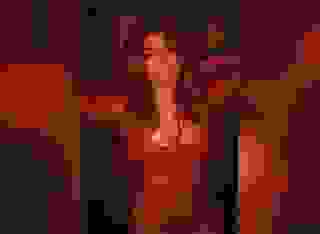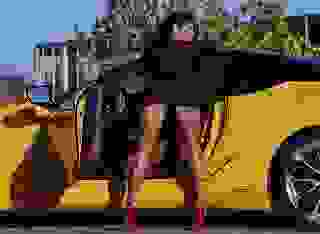Note: You can change font size, font face, and turn on dark mode by clicking the "A" icon tab in the Story Info Box.
You can temporarily switch back to a Classic Literotica® experience during our ongoing public Beta testing. Please consider leaving feedback on issues you experience or suggest improvements.
Click here"Precisely," Herman nodded vigorously. "They're less prone to some human fallacies, though it's possible that computers have illogical processes of their own that we don't know about. Hence the problem: How can we tell when a computer is right if we can't do the calculations ourselves?"
"I suppose we can ask another computer."
"That's one way; but two computers might agree and still be wrong, like false witnesses who corroborate each other's stories."
"All right then," Roger suggested, "we can test the calculation against the evidence."
"That's a second way, empirical testing. It works in science, where there are physical facts to check, but it doesn't work in pure mathematics or symbolic logic; and what about the physics of places we can't get to, such as the middle of black holes or quasars?"
"Then we can check the programs. If the program is sound, then the result must be reliable."
"Very good," Herman said, sounding like a teacher pleased by a star pupil, making Danielle smile as she brought the drinks over.
"But what if the program is so large or so complex that no one can analyse it?" the earnest young mathematician continued. "Most computer programs are now written by computers, which were themselves designed by computers and built by robots."
"Can we write a program to analyse the program?" Roger ventured.
"Yes, that's a good answer, it's the iterative method; but a program to analyse a program can still be too complex for human abilities. We call a program an 'algorithm' and each iteration we call a 'generation'. Rosa and I are studying algorithms of the fifth generation."
Roger surreptitiously counted the sequence off on his fingers as Herman elaborated:
"We write programs to analyse programs, to analyse programs, to analyse programs, to analyse programs that do the calculations."
"It's where I got the idea from for my iterative method of steering the traveller through hyperspace," Rosa said.
"It's a brilliant idea, Rosa," Danielle added; "and now that Roger has been put in his place, let's get to work on it."
Herman was mortified.
"I'm sorry, Roger. I didn't mean to lecture you. I got carried away. I'm new to programmable maths at this level and I'm only just realising what we can do with it."
"No apology necessary," Roger assured him. "I love to see people who are passionate about ideas."
None the less, her thought the earnest young man could benefit from a sense-of-humour algorithm.
* * *
Roger had work to do, so he took his coffee to the other side of the flat, where he sat at a table with a reading screen, a few hefty old-fashioned books and a tablet for his notes. He finished the brief outline for the sequel to his video film and sent it off. He then began to think about his latest research and was soon happily distracted by historical details, listening in on the Putney Debates or watching Cato's Letters seed and germinate in the American colonies.
Danielle, meanwhile, launched into an analysis of Rosa's method. She showed her attempt to solve its problems and then introduced Li's method. Distracted by physics, she clear forgot why she'd invited Rosa over; and the two women almost forgot Herman was there.
More than competent to follow the maths, Herman was unfamiliar with the physics and so had nothing to contribute at first, while Danielle showed Rosa the holographic images of the Samothean solar system. When they wrote equations on the large projection screen, however, he came alert and followed pretty well.
Things stopped for fifteen minutes when Roger got up to call his parents. He did so from Danielle's bedroom, inviting her to join him. They shared effusive congratulations but were soon back to their respective studies.
An hour later, Rosa said:
"I think we've reached an impasse. I can't see past the time-lag problem."
"Nor me," Danielle admitted.
"Herman, what do you think?" Rosa asked.
"I can follow the maths but not the underlying physics. Can you explain some things to me?"
"Of course. How rude of me to exclude you!", Danielle exclaimed. "We'll give you the short version of hyperspace engineering. I've done this for Roger many times, poor lamb. In fact, he makes a good sounding-board."
"The general principles are not too difficult, but if you find you don't understand, say so, and I'll explain. If it's something you need postgraduate physics to understand, then I'll say 'relativity theory' or 'quantum theory' and you'll just have to accept it. ... Shall we start?"
He nodded. Roger also put down his book and paid attention. There was a point in even the schoolboy version of hyperspace physics beyond which he could never progress but always hoped to.
"The standard way of explaining hyperspace is to picture a balloon," Danielle said and commanded the computer to project a holographic image of a child's rubber balloon over the coffee table. With a finger in the air, she drew an X on one side of the balloon and a Y on the other.
"Now, the three-dimensional space of our universe is represented by the two-dimensional surface of a balloon."
"I see," Herman said.
"That's the first place I get lost," Roger said from across the room.
"I know, Darling," Danielle said. "It's because you try to imagine it but you should just follow the logic."
"I wish I could," he sighed.
"Just suppose that space has two dimensions, like a surface, not three dimensions, like a solid, so there's left and right and forward and backward but no up and down."
That made it no clearer for her fiancé, but Danielle went on.
"So, what's the quickest way to get from X to Y?"
"Well," Herman said, "assuming I can travel only through space, then it has to be this way ..."
He drew a line with his finger on the surface of the balloon from X to Y. Danielle smiled happily at his understanding.
"Quite right. But the actual quickest route is this one." She put her thumb on the X and a finger on the Y and squeezed the sides of the balloon together.
"A hyperspace path is a like pinching the balloon so that distant parts of the surface meet. Of course, what we actually do is make a bubble of hyperspace around a spaceship."
"The technical name for the hyperspace bubble is a 'plume' and the technical name for anything the plume transports is a 'traveller'. The way it works is that you point the traveller in the direction you want to go and you make a plume of a given quantity of energy. The more energy you give it, the further it goes. However, the trajectory of the plume is extremely sensitive to what we call 'anomalies', which are any sources of energy in the pathway of the plume, except for gravitational energy."
"Why is gravitational energy not an anomaly?" Herman wondered.
"Because gravitational energy is equivalent to the curvature of space-time, which doesn't affect hyperspace," Danielle answered. "Also, 'relativity theory'."
"Go on. I'm following so far."
"Well, relativity theory says time and space are joined in a continuum, so movement in one is also movement in the other; but, in hyperspace, one can travel 'through' space without also travelling 'in' space ..."
He looked blank and Roger was lost again.
"... which also means that one can travel through space but without travelling in time. Travel in hyperspace is nearly instantaneous."
"All right, I get that ... sort of," he conceded. "So what kinds of anomalies are there?"
"Pulsars, neutron stars, strong radio sources, x-ray sources, gamma-ray sources; black holes, clouds of charged or magnetic particles, exotic matter - anything, in fact, that feels the electromagnetic, nuclear weak and nuclear strong forces."
"The disrupting effect of anomalies," Danielle continued, "means we can take only short jumps; after which we stop to make measurements. We find out where we are precisely, recalculate and jump again."
"It's very expensive on fuel because the real drain on energy is getting into hyperspace. 'Bouncing out' of hyperspace is energy-neutral. To go 100 light-years in two jumps actually takes a lot more energy than to go 200 light-years in one jump."
"So Rosa's method of 'jumping' all the way to Samothea in one go would save a fortune in energy costs."
"Yes."
"But didn't you say the quantity of energy given to the plume determines how far you jump?" Herman asked.
"Quite right, but 99% of the energy is used to get into hyperspace, regardless how far you jump."
"Would Rosa's method also be quicker?"
"Yes, because there's no need to stop and recalculate on the way. The only problem is, it won't work. Her technique involves taking measurements and recalculating as soon as the plume meets anomalies; but the calculations quickly go haywire if the mass of the traveller is not negligible."
"Why?"
"Because the anomaly changes the energy of the plume and we need to correct for that if we're not to bounce out of hyperspace a long way from the intended exit-point. The more mass, the longer and more difficult the calculation to find the right proportion. For a traveller of a hundred tonnes' mass in a leap of more than a few hundred light-years, the calculations become intractable and impossible in real-time."
"All right," Herman said, "So how come there's a time-lag in travelling through hyperspace? How come you don't travel instantaneously?"
Danielle beamed happily.
"Very good question. 'Special relativity' and 'quantum theory'."
"Oh." He sounded disappointed.
"I'll try to explain," Rosa said, having listened meekly all this time.
"In special relativity, no information-bearing signal can travel faster than light."
"Yes, but the plume isn't travelling in space."
"The plume is an interface between space and hyperspace, so part of it is in normal space-time and, as such, obeys quantum theory and special relativity. Quantum theory says there's a minimum time for a signal to pass through the plume. Special relativity says that a signal that travels within the plume cannot contain information because the plume itself is travelling faster than light (or it would be if it were travelling through normal space-time)."
"I'm lost again," Roger confessed to himself and returned to his history books. Danielle carried on:
"We've established that the plume's trajectory and energy cannot be precisely measured in real-time if the traveller is of any practical size; hence we come to Li's method."
"Li proposed a static hyperspace drive which sends out multiple plumes. If the traveller veers off-course, the next plume steers it back on-track. As you can see, it's the inverse of Rosa's method."
"How does Li's hyperspace drive know that the traveller has veered off track?"
"Because it's in constant contact with the plume."
"Isn't the plume many light-years away in seconds?"
"Not in hyperspace. In hyperspace, the plume is connected to the hyperspace drive until it collapses and the traveller bounces back into normal space."
This was puzzling and Herman stopped to think it over. Then:
"So why didn't Li's method work? If it can correct for anomalies, why was his traveller off-target?"
"For the same reason Rosa's method failed. They both work perfectly for a traveller with zero mass; and less well the more mass the traveller has. For a traveller with a few thousand tonnes, the calculations for Li's method are intractable and cannot keep up with the anomalies."
"So neither method will work?"
"Not as originally proposed; though Li's method may be easier to fix. We just need a lot more power. Then Li's method would be similar to something we already do. The permanent hyperspace pathways that take travellers from Earth to Capella Spaceport and onward to the inhabited galaxy are driven by large hyperspace drives with huge sources of power."
"That's why Capella is so well-placed. It's 'star' is actually four stars. They are tapped for fuel by giant collecting-stations, which beam the energy to a dozen or more hyperspace drives that power pathways in all directions. The other ends of the pathways also have hyperspace engines, making what we call 'tethered' pathways. The drives at each end are called 'beacons'. A pathway with powerful-enough beacons can ignore almost all anomalies. It's like a really powerful radio signal: it doesn't matter how much interference there is; so long as the signal is strong enough, it will get through."
Herman nodded his understanding.
"This is where we came in, isn't it?" he observed. "You showed that Rosa's method alone wouldn't work and then you tried to combine her method with Li's."
"Exactly. I wanted to use Rosa's method to make the corrections in trajectory and Li's method to make corrections in energy. It would simplify the calculation for her traveller and reduce the power Li needs; but it doesn't work, either. We're always stumped by the impossibility of getting Rosa's traveller to communicate with Li's beacon."
"Because of special relativity?"
"Correct. The traveller is effectively going faster-than-light relative to the beacon; so, while the traveller can talk to the plume and the plume can talk to the beacon, the traveller cannot talk to the beacon through the plume. The information always gets scrambled."
"All right. I think I'm clear now." Herman prepared himself for renewed mental effort; but Danielle said:
"Before we start, I have a question for Roger."
"Yes, Dear?"
"Why am I hungry?"
"Because it's two o'clock in the afternoon and we haven't even had breakfast."
"How did it get to be 2pm? Rosa and Herman only got here ten minutes ago."
"Three hours ago."
"Good Lord! Sorry, everyone. You must be starving. I'll make us some lunch. Is scrambled eggs all right?"
"Darling," Roger halted her. "Do you want Rosa and Herman to remain friends with us?"
"Of course I do!"
"Then do you really think you should cook?"
"Oh, God! You're right."
Danielle was not a bad cook generally, but when her mind was distracted, she was a disaster.
"Rosa," she asked, "can you cook?"
"I'll cook," Roger said.
He retired to the kitchen to make scrambled eggs, toast, coffee and fruit-juice. He used almost every pan Danielle possessed, even though she had a robotic oven that would have done most of the work.
After the late lunch, Roger went back to his historical studies, leaving the others to ponder the problem of combining Rosa's method with Li's. He kept an ear open for signs of progress but there was still none by four o'clock, when Roger got up to perform more hostly duties by making tea. He forced them to stop work for five minutes to drink it; then he left them alone for another marathon session.
At six o'clock, he called the restaurant to cancel the table and ask them to deliver the food instead. He ordered boeuf bourguignon for four and a bottle of wine, paying with Danielle's credit stick, telling her that she had lots of money and it was better to spend it on good food than on clothes she would wear only once or (God forbid!) even more handbags.
She murmured something, which he took as an assent. The three of them worked in silence, at a holo-screen or tablet, or just staring into space, thinking.
Dinner arrived at 8pm and was a welcome surprise. Although they began the meal eating mechanically, minds winding down from intense activity, they followed Roger's advice to enjoy the food and rest their brains a little. Danielle and Rosa joined Roger in a glass of wine: Herman stuck to water. Eventually they relaxed and their glazed expressions softened.
It was now that the large lump of information Roger had swallowed while Herman was having his lesson began to digest in his mind. Enquiries percolated up. He let the others sit in silence all through dinner; but when they finished their coffees and got up to resume working, he asked his question:
"Darling, can you explain something about what was said earlier?"
"I'll try."
"Rosa was quite specific in her language when she said 'No information-bearing signal can travel faster than light'. Does that imply that signals that don't bear information can travel faster than light?"
"Faster than light in a vacuum, yes."
"Oh. But isn't light the fastest thing there is?"
"Yes, ignoring hypothetical particles with imaginary mass."
"I don't get it."
"You're probably confused by a popular version of special relativity, which says 'Nothing can go faster than the speed of light in a vacuum'. In fact, microwaves in a wave-guide go faster than light (though they're made of light themselves). In general, photons subject to the tunnel effect go faster than the speed of light in a vacuum."
Roger was mystified.
"So if light can travel faster than light, why can't you send information faster than light?"
"Because the way the tunnel effect works is that photons get through only randomly, so the information a signal carries in a collection of photons is scrambled."
"Oh, all right." Roger was glad he asked but wasn't sure he followed the answer.
He left them sitting comfortably, neglecting the holo-screens, going over their calculations and racking their brains for a new idea. Roger also pondered what they'd told him, trying to make sense of it as well he could. He began looking things up on the computer, such as the difference between problems men can solve, problems only computers can solve and problems neither men nor computers can solve.
An hour later he thought he'd understood something and asked Danielle how they were getting on.
"We've made some progress but we're still stuck on the main problem," Danielle admitted. "With a powerful enough beacon, we can send a moderately massive traveller but we cannot properly control the direction. The impossibility of communicating the effect of the anomalies beats us every time."
"I've been thinking. What about triangulation?" Roger asked.
"What do you mean?"
"Remember the three ways of checking a computer's calculation that I discussed with Herman? There were empirical tests, the iterative method and the third method, comparing information from different sources. I looked it up. I think it's the same as something called 'triangulation'."
"Well, Li's method is like empirical tests because the beacon gets information from the plume and sends out corrections, like doing experiments and testing them. Rosa's method is the iterative one, it makes corrections to corrections to corrections. So the third one is triangulation, getting to the same answer by using different sources."
"Oh, Roger! It's pure coincidence that you mentioned only three mathematical methods. You might also have mentioned approximate methods, like finding cube roots ..."
Roger appeared deflated.
"Sorry, Darling," she said in mollifying tones, "There's no connection between the methods. One is mathematical ..."
She paused and then carried on, just from inertia.
"the other is physical ..." she stopped again. She stared blindly at him, her mind racing.
"Good God! ... He's right! ... Triangulation! Plume, traveller and beacon. ... Do you see it? Good God! My fiancé's a genius!"
"I don't see it," Herman said. Rosa was standing up. Eyes shut. Thinking hard.
She spoke quickly, squeezing her fists. "We know the energy from Li's method and the traveller knows the direction by my iterative method; so we just need to get them to communicate - which is impossible. But we don't need to get them to communicate information. We just need to keep them synchronised through the plume. So long as they're synchronised, we can adjust the plume according to what it experiences in hyperspace. The plume knows where it is. We just need to triangulate the three sources of information."
Danielle beamed at her, summing up:
"The plume is like an automatic pilot that knows how to fly straight in a particular direction and height and therefore corrects any deviation out of its path but it doesn't know what it's actual destination is."








